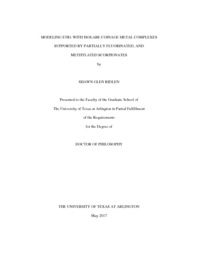| dc.description.abstract | Ethylene is a small molecule that functions as a plant hormone that is closely associated with several vital plant functions ranging from germination, shoot and root growth, sex expression, fruit ripening, senescence and abscission. This gaseous hormone is produced by almost every part of the plant, and mediates these processes throughout out the life of the plant. The ethylene response in many plants is initiated by a group of 5 copper based membrane bound receptors, mainly ETR1 (ethylene receptor 1). These receptors are made up of homodimers linked at their N-termini by two disulfide bonds. Each of the monomer units is composed of three transmembrane α-helices followed by a GAF and kinase domain, and the copper ethylene binding site is located in the endoplasmic reticulum (ER).
While the native receptor is copper based, it has been shown that the group 11 metals (Cu, Ag, Au) can all support ethylene binding in the receptor. Interestingly, silver is well known to block the ethylene response when applied as a pretreatment solution, whereas copper and gold are both known initiate the response. It is thought that the ethylene response is initiated by the binding of ethylene to the metal center in the receptor, followed by a conformational change, and the release of ethylene. It is not fully understood why silver blocks the signaling of the receptor, but it is probably due to the weak interactions of silver compared to copper and gold. In order to further explore the interactions of the coinage metals and ethylene we have isolated and fully characterized the group 11 metal adducts [HB(3-(CF3),5-(CH3)Pz)3]M(C2H4) (M = Au, Ag, and Cu; Pz = pyrazolyl) and [HB(3-(CF3),5-(Ph)Pz)3]Ag(C2H4). The gold adduct adopts a trigonal planar geometry with a κ2 bound scorpionate and has the strongest interaction between the metal center and ligands compared to the silver adducts which have distorted tetrahedral geometry and κ3 bound scorpionates. The structure, ethylene-bonding, and the group trends in these two isoleptic coinage metal-ethylene adduct series are discussed in chapter 2.
The silver complexes [HB(3-(CF3),5-(Ph)Pz)3]AgL (L = C6H6, CO, or PPh3) have been synthesized and characterized by NMR spectroscopy, and by X-ray crystallography. In all cases the Scorpionate is bound to silver in typical 3-fashion. The benzene adduct is bound in 2-fashion to silver and the room temperature solution NMR spectra show only one sharp proton and one carbon signal corresponding to benzene which points to fluxional behavior in solution. The 13C NMR resonance corresponding to the CO moiety of [HB(3-(CF3),5-(Ph)Pz)3]Ag(CO) appears as a singlet at δ 177.4 ppm in CD2Cl2 and the characteristic carbonyl stretch appears at ῡ 2148 cm-1. These data indicate diminished AgCO -backbonding. Interesting coupling is observed in the solution 19F and 19P NMR spectra of the Ag(I) adduct [HB(3-(CF3),5-(Ph)Pz)3]Ag(PPh3). A detailed analysis of the spectral and structural features of these complexes has been described in chapter 3.
The new poly(pyrazolyl)methane based ligand [(Ph3B)CH(3,5-(CH3)2Pz)2]- has been prepared and the copper adducts [(Ph3B)CH(3,5-(CH3)2Pz)2]Cu(L) (where L = C2H4, and cis-CH3HC=CHCH3) have been isolated and characterized by NMR spectroscopy and X-ray crystallography. This monoanionic bidentate ligand analog of bis(pyrazolyl)borate has been prepared using closely related bis(pyrazolyl)methane and triarylboron, and has allowed for the isolation of the first copper-ethylene adduct of a bidentate poly(pyrazolyl) base ligand. | |


